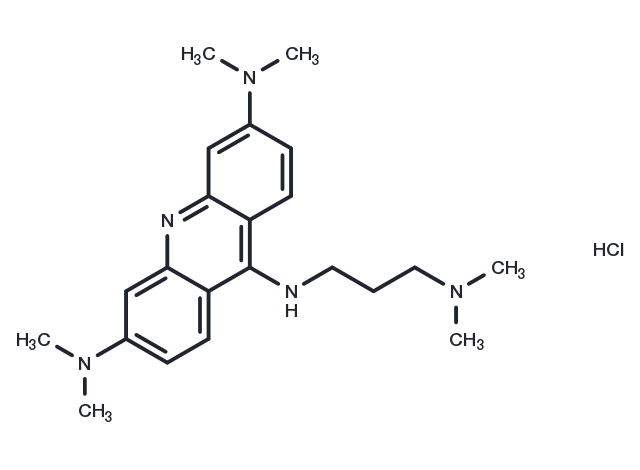Powder: -20°C for 3 years | In solvent: -80°C for 1 year


3,6-DMAD hydrochloride functions as an inhibitor for the IRE1α-XBP1 pathway within the unfolded protein response mechanism.

| Pack Size | Availability | Price/USD | Quantity |
|---|---|---|---|
| 5 mg | Inquiry | $ 320.00 |
| Description | 3,6-DMAD hydrochloride functions as an inhibitor for the IRE1α-XBP1 pathway within the unfolded protein response mechanism. |
| In vitro | The compound 3,6-DMAD effectively impedes IRE1α oligomerization as well as its endoribonuclease (RNase) activity in vitro. |
| In vivo | 3,6-DMAD (10 mg/kg, i.p., once every 12 h, total thrice) significantly inhibits in vivo XBP1-luciferase activity assessed 3.5 days after the initial treatment. 3,6-DMAD-treatment significantly inhibits tumor xenograft growth. |
| Kinase Assay | IRE1α oligomerization assay is set up using the nuclease reaction buffer, 2 μM recombinant hIRE1α, 2 mM ADP, and 60 μM of 3,6-DMAD. All reactions are performed in 20 μL with 10% DMSO to account for the vehicle and incubated for 15 min at 30 °C to allow for oligomerization. The optical density of the sample is measured at 500 nm using a NanoDrop 2000. |
| Cell Research | 2×10^4 cells per well are plated into 96-well plates and treatment started 0-12 hours after plating. RPMI 8226 and MM1.R human MM cells are treated with 0-6 μM 3,6-DMAD. After 24 hours of treatment, XTT reagent (ATCC) is added to the wells then cells are incubated for 2 hours and absorbance measured at both 475 nM and 660 nM using a plate reader. |
| Animal Research | 5×10^6 RPMI 8226 cells are implanted subcutaneously into the flanks of 4-6 weeks' old NOD Scid mice. Drug treatment started when the sizes of the tumors reached 150 mm3. Four tumor-bearing mice per group are treated with 10 mg/kg 3,6-DMAD or vehicle (saline) intraperitoneally once every 2 days. |
| Molecular Weight | 365.52 |
| Formula | C22H31N5xHCl |
| CAS No. | T10102 |
Powder: -20°C for 3 years | In solvent: -80°C for 1 year
DMSO: 25 mg/mL (68.40 mM), Sonification is recommended.
You can also refer to dose conversion for different animals. More
bottom
Please see Inhibitor Handling Instructions for more frequently ask questions. Topics include: how to prepare stock solutions, how to store products, and cautions on cell-based assays & animal experiments, etc.
3,6-DMAD hydrochloride T10102 Others 3,6-DMAD Hydrochloride 3,6DMAD hydrochloride 3,6 DMAD hydrochloride inhibitor inhibit
